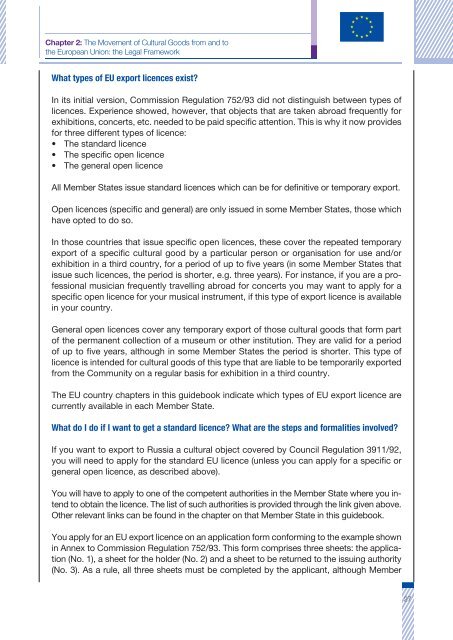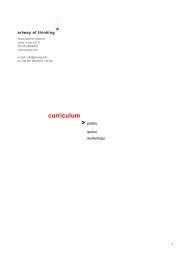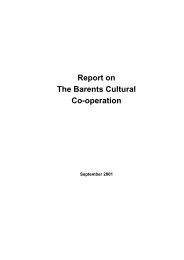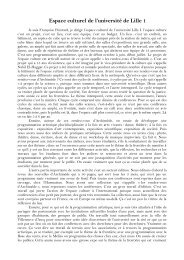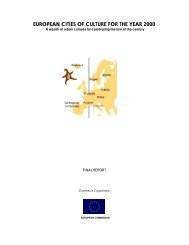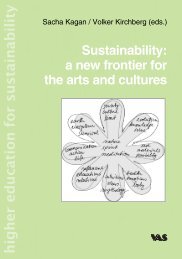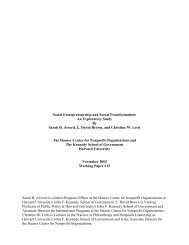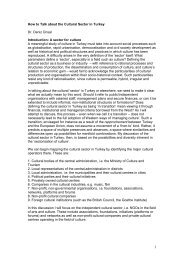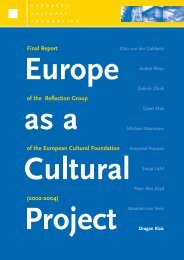A guide to the export and import of cultural goods between Russia ...
A guide to the export and import of cultural goods between Russia ...
A guide to the export and import of cultural goods between Russia ...
You also want an ePaper? Increase the reach of your titles
YUMPU automatically turns print PDFs into web optimized ePapers that Google loves.
Chapter 2: The Movement <strong>of</strong> Cultural Goods from <strong>and</strong> <strong>to</strong><br />
<strong>the</strong> European Union: <strong>the</strong> Legal Framework<br />
What types <strong>of</strong> EU <strong>export</strong> licences exist?<br />
In its initial version, Commission Regulation 752/93 did not distinguish <strong>between</strong> types <strong>of</strong><br />
licences. Experience showed, however, that objects that are taken abroad frequently for<br />
exhibitions, concerts, etc. needed <strong>to</strong> be paid specific attention. This is why it now provides<br />
for three different types <strong>of</strong> licence:<br />
• The st<strong>and</strong>ard licence<br />
• The specific open licence<br />
• The general open licence<br />
All Member States issue st<strong>and</strong>ard licences which can be for definitive or temporary <strong>export</strong>.<br />
Open licences (specific <strong>and</strong> general) are only issued in some Member States, those which<br />
have opted <strong>to</strong> do so.<br />
In those countries that issue specific open licences, <strong>the</strong>se cover <strong>the</strong> repeated temporary<br />
<strong>export</strong> <strong>of</strong> a specific <strong>cultural</strong> good by a particular person or organisation for use <strong>and</strong>/or<br />
exhibition in a third country, for a period <strong>of</strong> up <strong>to</strong> five years (in some Member States that<br />
issue such licences, <strong>the</strong> period is shorter, e.g. three years). For instance, if you are a pr<strong>of</strong>essional<br />
musician frequently travelling abroad for concerts you may want <strong>to</strong> apply for a<br />
specific open licence for your musical instrument, if this type <strong>of</strong> <strong>export</strong> licence is available<br />
in your country.<br />
General open licences cover any temporary <strong>export</strong> <strong>of</strong> those <strong>cultural</strong> <strong>goods</strong> that form part<br />
<strong>of</strong> <strong>the</strong> permanent collection <strong>of</strong> a museum or o<strong>the</strong>r institution. They are valid for a period<br />
<strong>of</strong> up <strong>to</strong> five years, although in some Member States <strong>the</strong> period is shorter. This type <strong>of</strong><br />
licence is intended for <strong>cultural</strong> <strong>goods</strong> <strong>of</strong> this type that are liable <strong>to</strong> be temporarily <strong>export</strong>ed<br />
from <strong>the</strong> Community on a regular basis for exhibition in a third country.<br />
The EU country chapters in this <strong>guide</strong>book indicate which types <strong>of</strong> EU <strong>export</strong> licence are<br />
currently available in each Member State.<br />
What do I do if I want <strong>to</strong> get a st<strong>and</strong>ard licence? What are <strong>the</strong> steps <strong>and</strong> formalities involved?<br />
If you want <strong>to</strong> <strong>export</strong> <strong>to</strong> <strong>Russia</strong> a <strong>cultural</strong> object covered by Council Regulation 3911/92,<br />
you will need <strong>to</strong> apply for <strong>the</strong> st<strong>and</strong>ard EU licence (unless you can apply for a specific or<br />
general open licence, as described above).<br />
You will have <strong>to</strong> apply <strong>to</strong> one <strong>of</strong> <strong>the</strong> competent authorities in <strong>the</strong> Member State where you intend<br />
<strong>to</strong> obtain <strong>the</strong> licence. The list <strong>of</strong> such authorities is provided through <strong>the</strong> link given above.<br />
O<strong>the</strong>r relevant links can be found in <strong>the</strong> chapter on that Member State in this <strong>guide</strong>book.<br />
You apply for an EU <strong>export</strong> licence on an application form conforming <strong>to</strong> <strong>the</strong> example shown<br />
in Annex <strong>to</strong> Commission Regulation 752/93. This form comprises three sheets: <strong>the</strong> application<br />
(No. 1), a sheet for <strong>the</strong> holder (No. 2) <strong>and</strong> a sheet <strong>to</strong> be returned <strong>to</strong> <strong>the</strong> issuing authority<br />
(No. 3). As a rule, all three sheets must be completed by <strong>the</strong> applicant, although Member<br />
27


